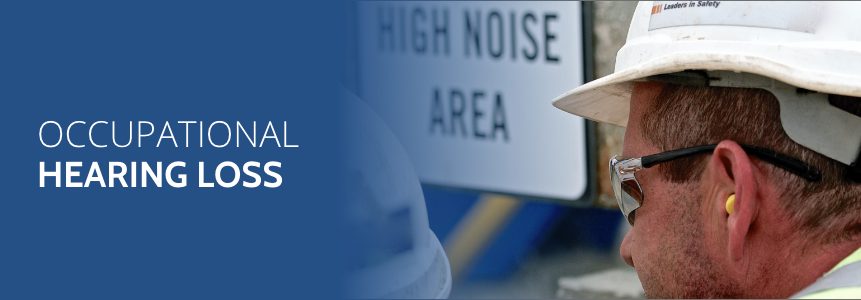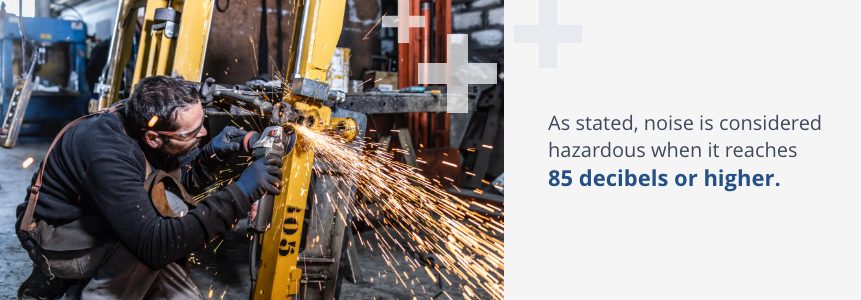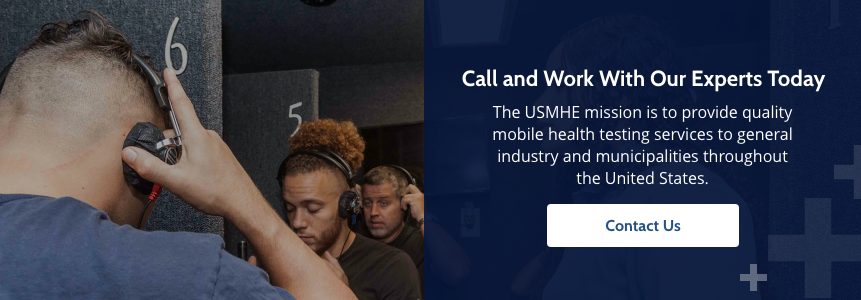
Unfortunately, many workers don’t realize they’re experiencing hearing damage, as it can take years of noise exposure to notice changes. To help combat hearing loss in the job field, organizations like the Occupational Safety and Health Administration (OSHA) have requirements regarding hearing protection that employers must follow to keep their employees safe.
Continue reading to learn more about common causes of occupational hearing loss (OHL) and how to ensure your workforce is protected.
 Common Causes of Occupational Hearing Loss
Common Causes of Occupational Hearing Loss
According to the National Institute for Occupational Safety and Health (NIOSH), OHL is defined as hearing loss that’s a result of exposure to ototoxic or poisonous chemicals or dangerous sound levels in the workplace. The two most common causes of OHL are extreme chemical and noise exposure.
Abbreviated as CIHL, chemically-induced hearing loss is a common result of occupational chemical exposure. The CDC states that ototoxic chemicals can cause OHL, making the ear more susceptible to the damaging effects of hazardous noise. Some ototoxic chemicals that can cause hearing loss are heavy metals, solvents and asphyxiants such as carbon monoxide.
As stated, noise is considered hazardous when it reaches 85 decibels or higher. Any work environment that produces noise at such high rates puts workers and passersby at risk for hearing damage. Specifically, workplaces that operate loud heavy machinery, such as airports, can put employees at risk.
In some industries, employees are exposed to both dangerous chemicals and noise, giving them a higher chance of hearing loss issues.
Handling Hearing Loss in the Workplace
Developing hearing loss can become a struggle in daily activities and at work. With hearing loss, it becomes more challenging to understand speech from a distance and with background noise. As a result, carrying conversations, listening to music, watching TV shows and participating in other activities where hearing is necessary can become increasingly difficult.
If you’re experiencing symptoms of hearing loss, which include hearing muffled noises and experiencing ringing in your ears, it’s wise to inform others sooner rather than later. By informing your employer and co-workers, you can work together to create an atmosphere that’s accessible and safe. Additionally, you can work together to reduce the chances of hearing loss. Correctly wearing the proper gear is only one way to ensure workers stay proactive.
As an employer, it’s crucial to be accommodating with workers who’ve displayed signs of hearing loss. Be sure to provide solutions that meet their needs while working to protect other employees in the same environment. Between offering protection and educating yourself, you can work on preventing workplace hearing loss.
What Are Hearing Conservation Programs?
OSHA has created standards specifically geared toward reducing the chance of hearing loss in the workplace. As you adopt their regulations, implementing a hearing conservation program at your business is another step in the right direction. These hearing conservation programs strive to prevent initial occupational hearing loss, preserve and protect the remaining hearing you or your employees have and equip your workers with the knowledge and hearing protection devices necessary for their safety.
When you develop a hearing conservation program, you’re responsible for monitoring noise exposure levels in your workplace. It’s important to keep track of any process or production changes within the workplace that may increase noise levels to ensure you’re continuously meeting all safety standards. Further, employers must create calibration procedures to ensure workers’ monitoring measurements are accurate.
Within your hearing conservation program, you can conduct different testing to ensure your workers’ safety. One form of testing is audiometric testing, which measures your employees’ abilities to hear sounds. This test will occur before your workers are exposed to loud working conditions to create a baseline of their hearing levels. The individuals will undergo the test at least once a year to determine whether they’ve experienced hearing loss based on their initial baseline test.
Conducting testing regularly is beneficial to your employees’ hearing, as you can identify possible hearing issues as they arise. To safeguard your employees’ hearing as much as possible, you can use U.S. Mobile Health Exams’ audiometric testing program. This testing is compliant with OSHA hearing regulations.
How to Begin an Employee Hearing Conservation Program
Now that you understand how beneficial it is to protect your employees’ safety, you may want to implement a hearing conservation program at your workplace. Here at U.S. Mobile Health Exams (USMHE), our experts will provide you with a comprehensive workplace noise monitoring assessment to use in building your company’s hearing conservation program.
These noise monitoring assessments are also known as noise surveys which involve using instruments to survey the noise levels in a facility. This assessment will provide you with the knowledge of which areas in your facility are generating high levels of noise. As a result, you can make the necessary changes to reduce noise levels or provide adequate protection when you can’t make the environment quieter.
At USMHE, we offer two types of noise surveys, which include area measurements and personal noise dosimetry.
- Area measurements: During an area measurement survey, we obtain comprehensive area measurements using an integrating sound level meter to identify hazardous noise levels where worker mobility isn’t a factor. The USMHE team performs noise exposure testing at specific workstations to capture a representative sample of employees’ exposure.
- Personal noise dosimetry: To identify noise-exposed workers, we conduct studies on work areas that are continually changing. The experts at USMHE use dosimeters to monitor at-risk employees for an entire shift. Then, the dosimeters summarize each employee’s measured actual average exposure and time-weighted average sound exposure. When a company selects the dosimetry survey, our surveyors will perform area measurements, too.
 Call and Work With Our Experts Today
Call and Work With Our Experts Today
The USMHE mission is to provide quality mobile health testing services to general industry and municipalities throughout the United States. The goal of our services is to greatly reduce disruption and cost. At USMHE, we offer a 100% customer guarantee on all of our services, and our prompt reporting and flexible scheduling make us a leader among noise-level testing and assessment companies.
Scheduling your area noise monitoring and hearing conservation testing with us is just one way you can help to create a healthy working environment. To learn more about our noise level monitoring services, call (904) 527-2296 or complete our online contact form to officially start your hearing conservation program.
Links
- https://www.cdc.gov/niosh/topics/noise/about.html
- https://www.cdc.gov/niosh/topics/ohl/default.html
- https://www.usmhe.com/wp-content/uploads/2019/04/Educational-Handout-Guide-To-Your-Hearing-Test.pdf
- https://www.osha.gov/laws-regs/regulations/standardnumber/1910/1910.95
- https://www.usmhe.com/services/hearing-conservation/
- https://www.usmhe.com/services/occupational-noise-monitoring-surveys/
- https://www.usmhe.com/contact-us/

 Common Causes of Occupational Hearing Loss
Common Causes of Occupational Hearing Loss